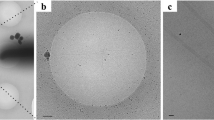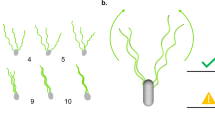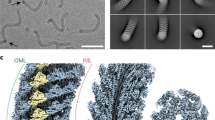Abstract
Bacterial flagella undergo transition between several discrete types of left-handed and right-handed helical structures when exposed to acidic1 or alkaline pH2, or to mechanical force3. Calladine4 and ourselves5 have presented models to explain such polymorphism, assuming that protein subunits (flagellin) in a flagellum can be transformed into two conformations (L- and R-states) depending on the species of flagellin and on the environmental conditions. An obvious prediction from these ‘two-state’ models is that there should be two types of straight flagella (L- and R-types) that are made up exclusively of flagel-lins in either the L-state or the R-state. We have shown that straight flagella from two species of mutants, Salmonella SJ814 (ref. 6) and Escherichla coli hag 177 (ref. 7), are closely similar to the predicted R- and L-types, respectively5. Recently we have isolated 10 strains of straight-flagellar mutants of Salmonella. We show here that their flagella can also be classified into the L-and the R-types, and that copolymerization of flagellins from two heterologous types (L and R) makes discrete types of helical filaments, whereas that of homologous pairs of flagellins (L and L, or R and R) makes only straight filaments.
This is a preview of subscription content, access via your institution
Access options
Subscribe to this journal
Receive 51 print issues and online access
$199.00 per year
only $3.90 per issue
Buy this article
- Purchase on Springer Link
- Instant access to full article PDF
Prices may be subject to local taxes which are calculated during checkout
Similar content being viewed by others
References
Kamiya, R. & Asakura, S. J. molec. Biol. 106, 167–186 (1976).
Kamiya, R. & Asakura, S. J. molec. Biol. 108, 513–518 (1977).
Macnab, R. M. & Ornston, M. K. J. molec. Biol. 112, 1–30 (1977).
Calladine, C. R. J. molec. Biol. 118, 457–479 (1978).
Kamiya, R., Asakura, S., Wakabayashi, K. & Namba, K. J. molec. Biol. 131, 725–742 (1979).
O'Brien, E. J. & Bennett, P. M. J. molec. Biol. 70, 132–152 (1972).
Kondoh, H. & Yanagida, M. J. molec. Biol. 96, 641–652 (1975).
Asakura, S. & Iino, T. J. molec. Biol. 64, 251–268 (1972).
Kuroda, H. Biochim. biophys. Acta 285, 253–267 (1972).
Author information
Authors and Affiliations
Rights and permissions
About this article
Cite this article
Kamiya, R., Asakura, S. & Yamaguchi, S. Formation of helical filaments by copolymerization of two types of ‘straight’ flagellins. Nature 286, 628–630 (1980). https://doi.org/10.1038/286628a0
Received:
Accepted:
Issue Date:
DOI: https://doi.org/10.1038/286628a0
This article is cited by
-
Torque transmission mechanism of the curved bacterial flagellar hook revealed by cryo-EM
Nature Structural & Molecular Biology (2019)
-
The wild-type flagellar filament of the Firmicute Kurthia at 2.8 Å resolution in vivo
Scientific Reports (2019)
-
A structural model of flagellar filament switching across multiple bacterial species
Nature Communications (2017)
-
Development of flagella bio-templated nanomaterials for electronics
Nano Convergence (2014)
-
Conformational change of flagellin for polymorphic supercoiling of the flagellar filament
Nature Structural & Molecular Biology (2010)
Comments
By submitting a comment you agree to abide by our Terms and Community Guidelines. If you find something abusive or that does not comply with our terms or guidelines please flag it as inappropriate.



